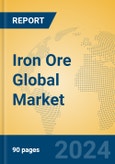Iron ore mining is a foundational industry supporting global steel production, critical for construction, automotive, and infrastructure sectors. With world resources exceeding 800 billion tons, containing over 230 billion tons of iron, the industry is characterized by abundant supply and concentrated production among a few major players. In 2024, global iron ore supply increased by 50-55 million tons, while demand dropped by approximately 25 million tons, shifting the market toward a looser balance. The "big four" miners - Vale, Rio Tinto, BHP, and Fortescue Metals Group (FMG) - produced 1.016 billion tons, up 1.26% year-over-year, with sales reaching 994 million tons, a 1.35% increase. BHP and FMG showed strong growth, while Rio Tinto saw a slight decline due to resource depletion and weather disruptions.
This product will be delivered within 1-3 business days.
Market Size and Growth Forecast
The iron ore market is anticipated to reach USD 115-125 billion by 2025, with a CAGR of 1%-2% through 2030, reflecting stable steel demand in emerging markets offset by declining growth in mature economies and surplus supply pressures.Regional Analysis
Asia Pacific, led by China, expects growth of 1.5%-2.5%, with China’s steel production driving imports, though trends show a shift toward scrap steel use. Oceania, primarily Australia, anticipates growth of 1%-2%, leveraging its export dominance to meet Asian demand. South America, notably Brazil, projects growth of 0.5%-1.5%, with Vale’s output supporting global supply. North America expects growth of 0.5%-1%, tied to infrastructure renewal, with minimal mining expansion. Europe anticipates growth of 0.5%-1.5%, reliant on imports for steelmaking.Application Analysis
- Steel Pipes: Projected at 1%-2%, driven by infrastructure and energy projects, with trends favoring corrosion-resistant alloys.
- Steel Rod and Wires: Expected at 0.5%-1.5%, used in construction, with steady demand.
- Steel Sheets: Anticipated at 1%-2%, key for automotive and appliances, with lightweight trends growing.
- Steel Plates: Projected at 1%-1.5%, vital for heavy machinery and ships, with stable growth.
Type Analysis
- Hematite: Expected at 1%-2%, dominant due to high iron content, with trends toward beneficiation.
- Magnetite: Projected at 1%-2.5%, valued for magnetic properties, with growth in processing technology.
- Limonite: Anticipated at 0.5%-1%, less common, with niche industrial use.
- Siderite: Expected at 0.5%-1%, limited by lower iron content, with minimal growth.
Key Market Players
- Vale: A Brazilian leader, Vale dominates global iron ore exports.
- Rio Tinto: An Australian giant, it focuses on high-grade ores.
- BHP: An Australian firm, BHP excels in cost-efficient production.
- Fortescue Metals: An Australian player, it rapidly expands output.
- Ansteel Group: A Chinese company, it integrates mining with steelmaking.
- ArcelorMittal: A global firm, it mines iron ore for its steel operations.
- Metalloinvest: A Russian leader, it serves European and Asian markets.
- NMDC: India’s top miner, it supports domestic steel growth.
- Rana Gruber: A Norwegian firm, it targets specialty ores.
- Companhia Siderurgica Nacional: A Brazilian company, it links mining to steel.
- Kumba Iron Ore: A South African player, it exports high-quality ore.
- Steel Authority of India: An Indian firm, it bolsters local supply.
Porter’s Five Forces Analysis
- Threat of New Entrants: Low. High capital and resource control limit entry.
- Threat of Substitutes: Low. Steel’s dominance ensures iron ore’s relevance.
- Bargaining Power of Buyers: High. Steel mills exploit oversupply to negotiate.
- Bargaining Power of Suppliers: Moderate. Big four dominance balances buyer power.
- Competitive Rivalry: Moderate. Key players compete on volume and cost.
Market Opportunities and Challenges
Opportunities
- Infrastructure Demand: Global projects sustain steel needs.
- Steel Innovation: High-strength alloys boost ore use.
- Emerging Markets: Asia and Africa drive growth.
- Recycling Synergy: Scrap complements primary ore.
- Supply Stability: Abundant reserves ensure availability.
Challenges
- Oversupply Risks: Excess production depresses prices.
- Demand Weakness: Steel output declines impact sales.
- Environmental Regulations: Stricter rules raise costs.
- Weather Disruptions: Production volatility affects supply.
- Economic Cycles: Industrial slowdowns reduce consumption.
This product will be delivered within 1-3 business days.
Table of Contents
Chapter 1 Executive SummaryChapter 2 Abbreviation and Acronyms
Chapter 3 Preface
Chapter 4 Market Landscape
Chapter 5 Market Trend Analysis
Chapter 6 Industry Chain Analysis
Chapter 7 Latest Market Dynamics
Chapter 8 Trading Analysis
Chapter 9 Historical and Forecast Iron Ore Market in North America (2020-2030)
Chapter 10 Historical and Forecast Iron Ore Market in South America (2020-2030)
Chapter 11 Historical and Forecast Iron Ore Market in Asia & Pacific (2020-2030)
Chapter 12 Historical and Forecast Iron Ore Market in Europe (2020-2030)
Chapter 13 Historical and Forecast Iron Ore Market in MEA (2020-2030)
Chapter 14 Summary For Global Iron Ore Market (2020-2025)
Chapter 15 Global Iron Ore Market Forecast (2025-2030)
Chapter 16 Analysis of Global Key Vendors
List of Tables and Figures
Companies Mentioned
- Vale
- Rio Tinto
- BHP
- Fortescue Metals
- Ansteel Group
- ArcelorMittal
- Metalloinvest
- NMDC
- Rana Gruber
- Companhia Siderurgica Nacional
- Kumba Iron Ore
- Steel Authority of India








